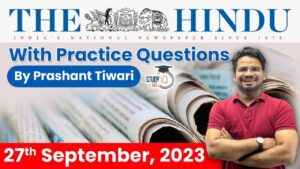The Hindu Newspaper Analysis for UPSC

The Hindu Newspaper Analysis 17 May 2023
- Two Constitution Benches of the Supreme Court of India delivered important judgments last week. The first case decided that the Delhi government headed by the Chief Minister — and not the Lieutenant Governor appointed by the central government — will control civil services working for the Delhi government. The second case involved the formation of the current government in Maharashtra following the “split” in the Shiv Sena party.
- The anti-defection law is based on the assumption that any vote by an MP/MLA against the party direction is a betrayal of the electoral mandate. This is an incorrect interpretation of representative democracy. While party affiliation is an important element in elections, it is not the sole criterion for voters.
The Hindu Editorial Today
- Parliament added it to the Constitution as the Tenth Schedule in 1985. Its purpose was to bring stability to governments by discouraging legislators from changing parties.
- The Tenth Schedule – popularly known as the Anti-Defection Act – was included in the Constitution via the 52nd Amendment Act, 1985.
- The decision on questions as to disqualification on ground of defection are referred to the Chairman or the Speaker of such House, which is subject to ‘Judicial review’.
- However, the law does not provide a timeframe within which the presiding officer has to decide a defection case.

- The Supreme Court’s exhortation to the Enforcement Directorate (ED) not to create an atmosphere of fear indicates how much the agency needs to temper its zeal in investigating allegations against political opponents of the current regime.
- A major complaint from the Opposition concerns the alleged politicisation of investigations and the personnel heading the agency. Some parties fear that the money-laundering law is being used for a political witch-hunt.
- About Enforcement Directorate:
- It is a Multi Disciplinary Organization mandated with the task of enforcing the provisions of two special fiscal laws – Foreign Exchange Management Act, 1999 (FEMA) and Prevention of Money Laundering Act, 2002 (PMLA).
- Historical background:
- The origin of this Directorate goes back to 1st May, 1956, when an ‘Enforcement Unit’ was formed, in Department of Economic Affairs, for handling Exchange Control Laws violations under Foreign Exchange Regulation Act, 1947 (FERA ’47).
- In the year 1957, this Unit was renamed as ‘Enforcement Directorate’. The administrative control of the Directorate was transferred from Department of Economic Affairs to Department of Revenue in 1960.
- For a short period of 04 years (1973 – 1977), the Directorate also remained under the administrative jurisdiction of Department of Personnel & Administrative Reforms.
- Composition:
- Besides directly recruiting personnel, the Directorate also draws officers from different Investigating Agencies, viz., Customs & Central Excise, Income Tax, Police, etc. on deputation.
- Other functions:
- Processing cases of fugitive/s from India under Fugitive Economic Offenders Act, 2018.
- Sponsor cases of preventive detention under Conservation of Foreign Exchange and Prevention of Smuggling Activities Act, 1974(COFEPOSA) in regard to contraventions of FEMA.
- Special courts:
- For the trial of an offence punishable under section 4 of PMLA, the Central Government (in consultation with the Chief Justice of the High Court), designates one or more Sessions Court as Special Court(s). The court is also called “PMLA Court”.
- Any appeal against any order passed by PMLA court can directly be filed in the High Court for that jurisdiction.

- Introspection will do India good in areas where it faces international criticism.
- There was little surprise about the manner in which the government reacted to the U.S. State Department’s report on India, and other countries, dealing with religious freedoms. The report, which was released by U.S. Secretary of State Antony Blinken, lists a number of incidents of “concern” over the “continued targeting of religious minorities”.
- The rejection of the report is in line with India’s past reaction, as both the U.S. Commission on International Religious Freedom (USCIRF), as well as the U.S. State Department Report that bases itself on USCIRF recommendations, have been increasingly critical of India.

- Worried that poor, less-educated women, particularly in rural areas, continue to be at higher risk of undergoing unnecessary and often unjustified hysterectomies, the Health Ministry has written to all stakeholders to work towards plugging “such hysterectomies performed by certain medical institutions”.
- The action comes following the Supreme Court’s direction last month, where the States and Union Territories were instructed to implement health guidelines formulated by the Centre to monitor “unnecessary” hysterectomies within three months.
- Hysterectomy is a surgical procedure to remove the uterus.
- A public interest litigation (PIL) petition filed before the Supreme Court had said that in Bihar, Chhattisgarh, and Rajasthan, “unnecessary hysterectomies” were carried out under the Rashtriya Swasthya Bima Yojana as well as other government schemes related to healthcare.
- The recent judgment also noted that the guidelines indicate that while in developed countries hysterectomies are typically conducted among premenopausal women above the age of 45, in India, community-based studies have consistently found rising hysterectomy rates among young women, ranging from 28 to 36 years of age.
- “The right to health is an intrinsic element of the right to life under Article 21 of the Constitution. Life, to be enjoyed in all its diverse elements, must be based on robust conditions of health. There has been a serious violation of the fundamental rights of the women who underwent unnecessary hysterectomies,’’ said the judgment.

- With fertilizer prices continuing to remain high due to global factors — such as a fall in production and hiked logistics costs, especially due to the Ukraine situation — the Centre expects this year’s fertilizer subsidy to cross ₹2.25 lakh crore. Accordingly, the Union Cabinet on Wednesday approved a ₹1.08 lakh crore subsidy for the ongoing kharif or monsoon season, Minister of Chemicals and Fertilizers Mansukh Mandaviya said.
- fertilisers – Urea and Di-Ammonium Phosphate (DAP).
- A fertiliser is a natural or artificial substance containing chemical elements (such as Nitrogen (N), Phosphorus (P) and Potassium (K)) that improve growth and productiveness of plants.
- There are 3 basic fertilisers in India – Urea, DAP and Muriate of Potash (MOP).
About Fertiliser Subsidy:
- The government pays a subsidy to fertiliser producers to allow farmers to buy fertilisers at below-market rates.
- The difference between the cost of production/import of a fertiliser and the actual amount paid by farmers is the subsidy portion borne by the government.
- Subsidy on Urea:
- In India, urea is the most produced, imported, consumed and physically regulated fertiliser of all. It is subsidised only for agricultural uses.
- The Centre pays a subsidy on urea to fertiliser manufacturers on the basis of cost of production at each plant and the units are required to sell the fertiliser at the government-set Maximum Retail Price (MRP).
- The use of N, P and K in the country has over the last few years sharply deviated from the ideal NPK use ratio of 4:2:1.
- The resulting nutrient imbalance owing to their use, disproportionate to other, more expensive fertilisers, could have implications for soil health, ultimately affecting crop yields.
- What are Rabi Crops?
- These crops are sown around the Retreating Monsoon and Northeast monsoon season, which begins in October and are called rabi or winter crops.
- The harvest for these crops happens typically during April and May, during the summer season.
- These crops are not much affected by the rainfall.
- Major Rabi crops are wheat, gram, peas, barley etc.
- A warm climate is required for seed germination and cold climate for the growth of crops.
- What are the Other Types of Crops grown in India?
Kharif Crops:
- Crops that are sown during the southwest monsoon season are called kharif or monsoon crops.
- These crops are sown at the beginning of the season around end May to early June and are harvested post the monsoon rains beginning October.
- These crops depend on the rainfall patterns.
- Rice, maize, pulses such as urad, moong dal and millets are among the key kharif crops.
- It requires a lot of water and hot weather to grow.

- It is near-certain that 2023-2027 will be the warmest five-year period ever recorded, the United Nations warned on Wednesday as greenhouse gases and El Nino combine to send temperatures soaring.
- There is a two-thirds chance that at least one of the next five years will see global temperatures exceed the more ambitious target set out in the Paris accords on limiting climate change, the UN’s World Meteorological Organization (WMO) said.
- The hottest eight years ever recorded were all between 2015 and 2022, with 2016 the warmest — but temperatures are forecast to increase further as climate change accelerates.
- The 2015 Paris Agreement saw countries agree to cap global warming at “well below” two degrees Celsius above average levels measured between 1850 and 1900 — and 1.5 degrees Celsius if possible.
- The global mean temperature in 2022 was 1.15 degrees Celsius above the 1850-1900 average.
- The WMO said there was a 66% chance that annual global surface temperatures will exceed 1.5 degrees Celsius above pre-industrial levels for at least one of the years 2023-2027, with a range of 1.1 degrees Celsius to 1.8 degrees Celsius forecasted for each of those five years.
Q) Consider the following statements regarding Mission LiFE (Lifestyle for Environment):
- It focuses on bringing about behaviour changes in individuals through simple and easy-to-do actions.
- The Ministry of Environment, Forest and Climate Change is the nodal Ministry for the coordination and implementation of the mission.
Which of the above statements is/are correct?
- 1 only
- 2 only
- Both 1 and 2
- Neither 1 nor 2
मिशन LiFE (पर्यावरण के लिए जीवन शैली) के संबंध में निम्नलिखित कथनों पर विचार करें:
- यह सरल और आसान कार्यों के माध्यम से व्यक्तियों में व्यवहार परिवर्तन लाने पर केंद्रित है।
- पर्यावरण, वन और जलवायु परिवर्तन मंत्रालय मिशन के समन्वय और कार्यान्वयन के लिए नोडल मंत्रालय है।
उपरोक्त कथनों में से कौन-सा/से सही है/हैं?
- केवल 1
- केवल 2
- 1 और 2 दोनों
- न तो 1 और न ही 2
Answer – C
What is Mission LiFE (Lifestyle for Environment)?
- It was launched by the Prime Minister on 20 October 2022 at Kevadia, Gujarat.
- The mission focuses on bringing about behaviour changes in individuals through simple and easy-to-do actions.
- It is envisioned as an India-led global mass movement that will nudge individual and collective action to protect and preserve the environment.
- The Ministry of Environment, Forest and Climate Change is the nodal Ministry for national-level coordination and implementation of Mission LiFE.
- The global movement will showcase sustainable goals and climate actions taken by countries and individuals around the world.
- To monitor the progress of LiFE, the Ministry has developed two dedicated portals.
- The Mission LiFE Portal (missionlife-moefcc.nic.in): Allows open access to download over 100 creatives, videos, and knowledge materials created by the Ministry for LiFE.
- The Meri LiFE Portal (merilife.org): Enables ministries and institutions to upload event reports and track the progress of the mass mobilization drive.
Q) Which one of the following countries is not a member of the Indo-Pacific Economic Framework for Prosperity (IPEF)?
- India
- United States
- Vietnam
- China
निम्नलिखित में से कौन सा देश समृद्धि के लिए भारत-प्रशांत आर्थिक ढांचे (आईपीईएफ) का सदस्य नहीं है?
- भारत
- संयुक्त राज्य अमेरिका
- वियतनाम
- चीन
Answer – D
About Indo-Pacific Economic Framework for Prosperity (IPEF):
- It is an economic initiative launched by United States President on May 23, 2022.
- IPEF has fourteen member states: Australia, Brunei, Fiji, India, Indonesia, Japan, South Korea, Malaysia, New Zealand, Philippines, Singapore, Thailand, United States and Vietnam.
- This framework is intended to advance resilience, sustainability, inclusiveness, economic growth, fairness, and competitiveness for member economies.
- The forum seeks to go beyond traditional free trade agreements and work on the issues of supply chains, clean energy, decarbonisation, infrastructure, and tax and anti-corruption.
- The initiative aims to contribute to cooperation, stability, prosperity, development, and peace within the Indo-Pcific region.
Q) With reference to the Wholesale Price Index (WPI), consider the following statements:
- The index has a total of 697 items, including Primary Articles (117), fuel and power (16), and Manufactured Products (564).
- Currently, the base year of WPI is 2019.
Which of the above statements is/are correct?
- 1 only
- 2 only
- Both 1 and 2
- Neither 1 nor 2
थोक मूल्य सूचकांक (WPI) के संदर्भ में निम्नलिखित कथनों पर विचार कीजिये:
- इंडेक्स में कुल 697 आइटम हैं, जिनमें प्राइमरी आर्टिकल्स (117), फ्यूल एंड पावर (16) और मैन्युफैक्चर्ड प्रोडक्ट्स (564) शामिल हैं।
- वर्तमान में WPI का आधार वर्ष 2019 है।
उपरोक्त कथनों में से कौन-सा/से सही है/हैं?
- केवल 1
- केवल 2
- 1 और 2 दोनों
- न तो 1 और न ही 2
Answer – A
What Is a Wholesale Price Index (WPI)?
Wholesale Price Index (WPI) represents the price of goods at a wholesale stage i.e. goods that are sold in bulk and traded between organizations instead of consumers.
The index has a total of 697 items, including Primary Articles (117), fuel and power (16), and Manufactured Products (564).
- The percentage increase in WPI over a year gives the rate of inflation for that year.
- Currently, the base year of WPI is 2011-12.
- WPI is used as an important measure of inflation in India.
Q) With reference to the Central Consumer Protection Authority (CCPA), consider the following statements:
- It has been established in 2020 under section 10 of the Consumer Protection Act, 2019 that replaced Consumer Protection Act, 1986.
- The nodal Ministry is Union Ministry of Home Affairs.
Which of the above statements is/are correct?
- 1 only
- 2 only
- Both 1 and 2
- Neither 1 nor 2
केंद्रीय उपभोक्ता संरक्षण प्राधिकरण (CCPA) के संदर्भ में निम्नलिखित कथनों पर विचार कीजिये:
- इसे 2020 में उपभोक्ता संरक्षण अधिनियम, 2019 की धारा 10 के तहत स्थापित किया गया है, जिसने उपभोक्ता संरक्षण अधिनियम, 1986 को प्रतिस्थापित किया।
- नोडल मंत्रालय केंद्रीय गृह मंत्रालय है।
उपरोक्त कथनों में से कौन-सा/से सही है/हैं?
- केवल 1
- केवल 2
- 1 और 2 दोनों
- न तो 1 और न ही 2
Answer – A
About CCPA:
- It has been established in 2020 under section 10 of the Consumer Protection Act, 2019 that replaced Consumer Protection Act, 1986.
- It consists of the following members appointed by the Central Government-
- Chief Commissioner.
- Two Commissioners.
- One commissioner each will represent goods and services.
- Objective- To promote, protect and enforce the rights of consumers as a class.
- It will be empowered-
- To conduct investigations into violation of consumer rights and institute complaints / prosecution,
- Order recall of unsafe goods and services,
- Order discontinuation of unfair trade practices and misleading advertisements,
- Impose penalties on manufacturers/ endorsers/ publishers of misleading advertisements.
- Nodal Ministry: The Ministry of Consumer Affairs.


 The Hindu Newspaper Analysis 6 October 2...
The Hindu Newspaper Analysis 6 October 2...
 The Hindu Newspaper Analysis 30 Septembe...
The Hindu Newspaper Analysis 30 Septembe...
 The Hindu Newspaper Analysis 27 Septembe...
The Hindu Newspaper Analysis 27 Septembe...





















